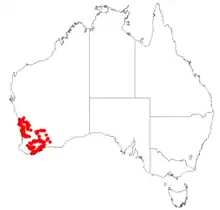Pimelea sulphurea
Pimelea sulphurea, commonly known as yellow banjine,[2] is a species of flowering plant in the family Thymelaeaceae and is endemic to the south-west of Western Australia. It is an erect, spindly or open shrub with narrowly elliptic to more or less round leaves, and compact heads of pendulous, yellow flowers surrounded by 3 or more pairs of green to yellowish involucral bracts.
| Pimelea sulphurea | |
|---|---|
.jpg.webp) | |
| Scientific classification | |
| Kingdom: | Plantae |
| Clade: | Tracheophytes |
| Clade: | Angiosperms |
| Clade: | Eudicots |
| Clade: | Rosids |
| Order: | Malvales |
| Family: | Thymelaeaceae |
| Genus: | Pimelea |
| Species: | P. sulphurea |
| Binomial name | |
| Pimelea sulphurea | |
 | |
| Occurrence data from Australasian Virtual Herbarium | |
| Synonyms[1] | |
|
Calyptrostegia sulphurea Walp. | |
Description
Pimelea sulphurea is an erect, spindly or open shrub that typically grows to a height of 15–70 cm (5.9–27.6 in) and has glabrous stems. The leaves are arranged in opposite pairs and are narrowly elliptic to more or less round, 2–16 mm (0.079–0.630 in) long, 1.5–9 mm (0.059–0.354 in) wide and more or less sessile. Both sides of the leaves are the same shade of green and glabrous. The flowers are usually bisexual and borne in compact, pendulous clusters of many more or less glabrous yellow flowers, surrounded by 3 or more pairs of narrowly elliptic to round involucral bracts 4–15 mm (0.16–0.59 in) and 3–10 mm (0.12–0.39 in) wide. The bracts are green or yellowish and hairy on the insde surface. The floral tube is 6.5–17 mm (0.26–0.67 in) long, and the sepals are 2–5 mm (0.079–0.197 in) long. Flowering occurs from July to November.[2][3]
Taxonomy
Pimelea sulphurea was first formally described in 1848 by Carl Meissner in Botanische Zeitung.[4][5] The specific epithet, (sulphurea) means "sulfur-coloured".[6]
In 1852, Wilhelm Walpers gave this species the name Calyptrostegia sulphurea in Annales Botanices Systematicae,[7][8] and in 1891 Otto Kuntze gave it the name Banksia sulfurea in Revisio Generum Plantarum,[9][10] but both names are regarded as synonyms by the Australian Plant Census.[1]
Distribution and habitat
Yellow banjine usually grows on sand in woodland or shrubland between Eneabba, Fitzgerald River National Park and Southern Cross in the Avon Wheatbelt, Coolgardie, Esperance Plains, Geraldton Sandplains, Jarrah Forest, Mallee, and Swan Coastal Plain bioregions of south-western Western Australia.[2][3]
Conservation status
Pimelea sulphurea is listed as "not threatened" by the Government of Western Australia Department of Biodiversity, Conservation and Attractions.[2]
References
- "Pimelea sulphurea". Australian Plant Census. Retrieved 13 April 2023.
- "Pimelea sulphurea". FloraBase. Western Australian Government Department of Biodiversity, Conservation and Attractions.
- Rye, Barbara L. "Pimelea sulphurea". Flora of Australia. Australian Biological Resources Study, Department of Agriculture, Water and the Environment: Canberra. Retrieved 13 April 2023.
- "Pimelea sulphurea". APNI. Retrieved 13 April 2023.
- Meissner, Carl (1848). "Bemerkungen zu den Pflanzen des Hr. Dr. Behr in Sudaustralien". Botanische Zeitung. 6: 396. Retrieved 14 April 2023.
- Sharr, Francis Aubi; George, Alex (2019). Western Australian Plant Names and Their Meanings (3rd ed.). Kardinya, WA: Four Gables Press. p. 318. ISBN 9780958034180.
- "Calyptrostegia sulphurea". APNI. Retrieved 14 April 2023.
- Walpers, Wilhelm G. (1852). Annales botanices systematicae. Vol. 3. Leipzig. p. 325. Retrieved 14 April 2023.
{{cite book}}: CS1 maint: location missing publisher (link) - "Banksia sulphurea". APNI. Retrieved 14 April 2023.
- Kuntze, Otto (1891). Revisio Generum Plantarum. Vol. 2. Leipzig. p. 583. Retrieved 14 April 2023.
{{cite book}}: CS1 maint: location missing publisher (link)
External links
- AVH: Occurrence data for Pimelea sulphurea. Australasian Virtual Herbarium. Retrieved 31 August 2018.